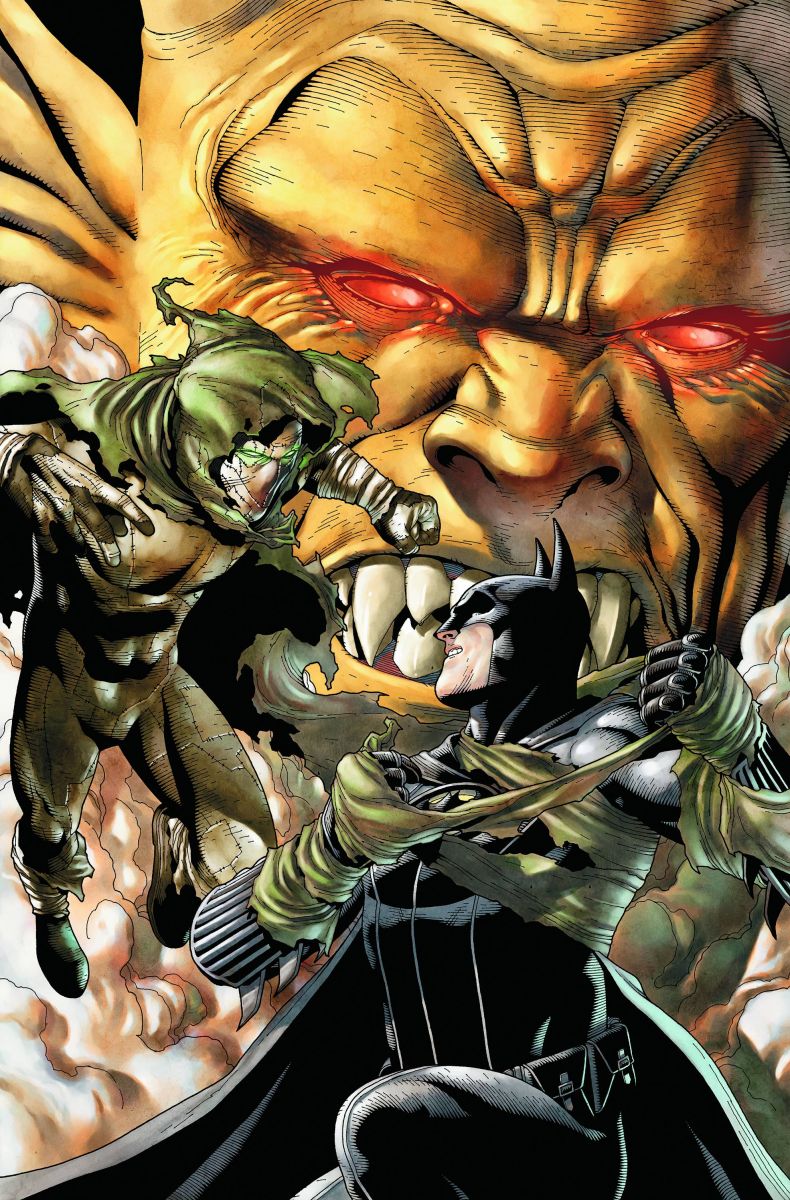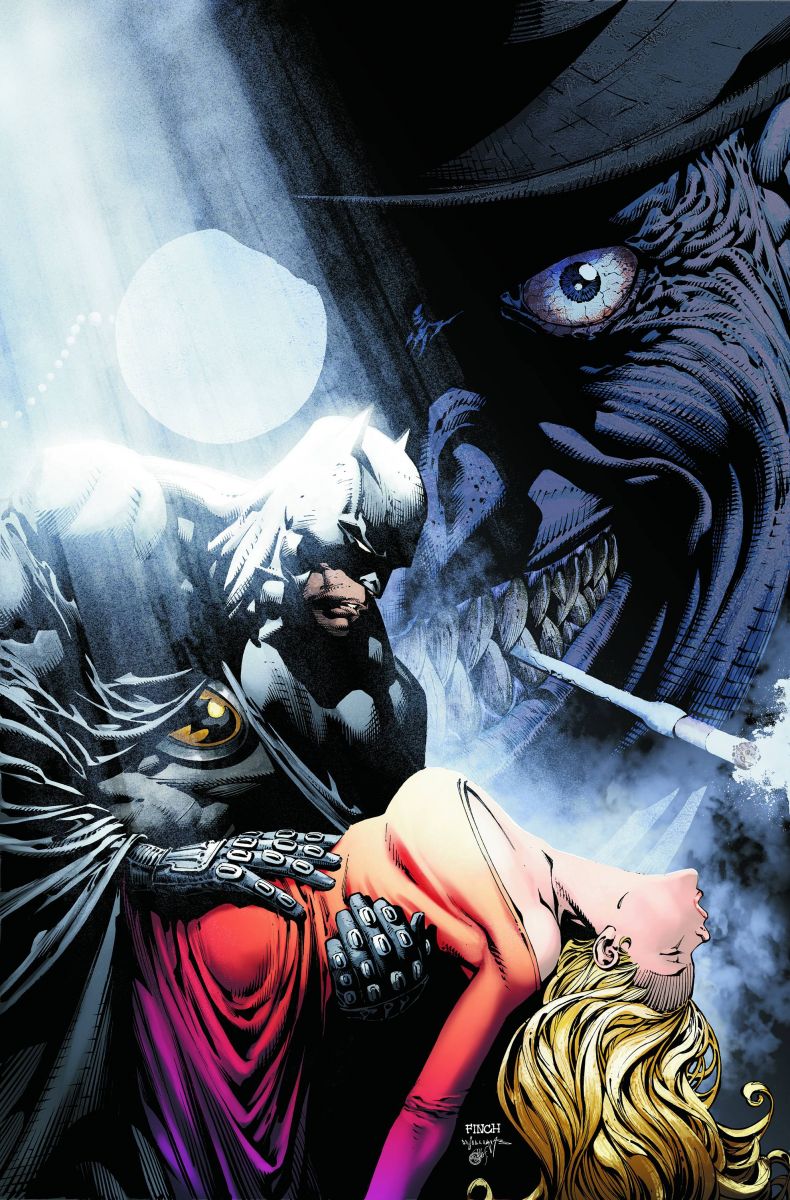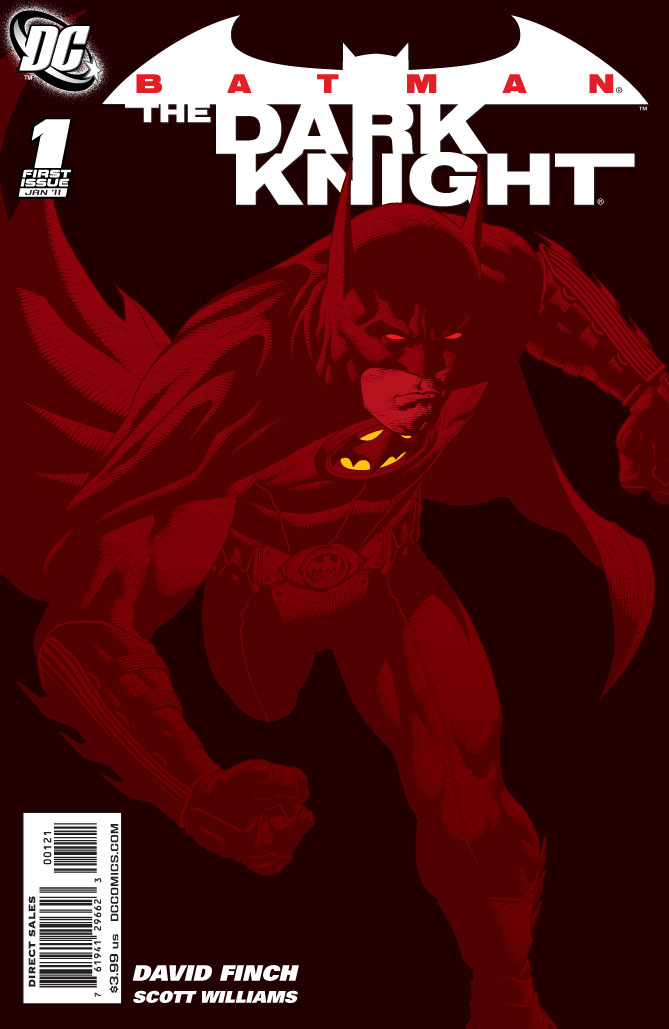David Finch became a comics superstar the old-fashioned way; he worked at it. After years as one of Top Cow's mainstay artists, he made the jump to Marvel in 2002, teaming with Brian Bendis first on Ultimate X-Men, and later on Avengers: Disassembled and New Avengers, which cemented his place as one of the top artists in the industry. He followed that by revitalizing the character Moon Knight for a new generation, and then returned to the Ultimate Universe with writer Jeph Loeb for the blockbuster Ultimatum series.
After such a distinguished career at Marvel, it came as a shock to many when it was announced in January of this year that Finch had signed an exclusive contract with DC Comics. But as Finch explains in a candid conversation, there was one character that was reason enough to get him to make that jump. That character, Batman, is the star of a brand new series, Batman: The Dark Knight, which Finch is both writing and drawing. I spoke with Finch to get the whys and wherefores of his decision, as well as to learn where he intends to take The Dark Knight.
 Matt Adler: Can you tell us a bit about how you wound up coming to DC and doing Batman: The Dark Knight?
Matt Adler: Can you tell us a bit about how you wound up coming to DC and doing Batman: The Dark Knight?
David Finch: I called Dan DiDio kind of out of the blue. I'd talked to him a few times in the past, but I'd wanted to do Batman for a very, very long time. So I gave him a call and said this is something I’d be really interested in doing, and if DC had a spot for me drawing the character, I would jump on it. And thankfully, they found a spot for me drawing the character, so it worked out pretty well.
MA: Was getting to write and draw your own book a big part of making the decision to go exclusive with DC?
DF: Not at all, actually. Being able to draw Batman was 100% of my decision to sign with DC. I still love Marvel to death and I had a great experience, and it was a really tough decision to leave Marvel. It was a very easy decision to come to DC; it was very difficult to leave Marvel. And I really wanted to draw Batman, and really, that was entirely the discussion when it came to coming to DC. Writing was a totally different issue. It was something I really wanted to do, but it didn’t play into me coming to DC, and it wasn't something where DC said "If you sign with DC, we'll let you write a book." It was not like that at all.
MA: But still, that's a pretty big thing, as far as giving an artist a brand new series with their flagship character to write and draw; that's not something we’ve seen since Todd McFarlane and Spider-Man. Do you see that as their expression of your value to them?
DF: Um… (laughs) I would like it if you could characterize it that way… why not, sure, that'd be nice. I think that it's unusual nowadays just because the quality of writing in comics is so much higher than it used to be that it's a real risk to let an artist, especially… I’ve had a little bit of writing experience, but not a whole lot. So, I've talked to editorial quite a bit, and Dan, about the things I really want to do with the character, and I think we’ve developed a comfort level based on talking about all those sorts of things, so it wasn't a complete shot in the dark. But yeah, I think it's a little unusual right now. I do believe, especially with the character of Batman, that the tone and the mood of the book is 80% of the job right there. And the more control I had over the story, the more control I had over the tone and the mood, and I think that's what we all wanted out of the series more than anything. So, it gave me the most control to be able to really refine that.
MA: What's going to set your Batman book apart from the others?
 DF: Well, it's Bruce Wayne fighting crime in Gotham City. Which, just on the face of it, would separate it from the others. Grant [Morrison] is doing Batman Incorporated, which really brings Bruce Wayne and the Batman brand all around the world, and broadens everything about the Bat universe in really interesting ways; I think it will affect Batman forever. And for me, I've always been a Batman fan, and I've always wanted to draw and write the sort of stories that I've always loved about Batman, so I’m really staying more traditional in terms of what I'm doing, and there really isn't another book like it right now. I think Scott Snyder’s got some amazing stuff with Dick Grayson; I love what he’s doing. But this book is traditional Bruce Wayne Batman fighting all the traditional villains. It's also got a bit of a supernatural flavor to it which I think is unique to this book; I’m bringing in Etrigan The Demon which is a character that I've always loved. He's got so much potential. And I want to be careful to not stray too far away from what Batman is to me, but adding that element takes you in some directions that haven't been explored quite as much with the character.
DF: Well, it's Bruce Wayne fighting crime in Gotham City. Which, just on the face of it, would separate it from the others. Grant [Morrison] is doing Batman Incorporated, which really brings Bruce Wayne and the Batman brand all around the world, and broadens everything about the Bat universe in really interesting ways; I think it will affect Batman forever. And for me, I've always been a Batman fan, and I've always wanted to draw and write the sort of stories that I've always loved about Batman, so I’m really staying more traditional in terms of what I'm doing, and there really isn't another book like it right now. I think Scott Snyder’s got some amazing stuff with Dick Grayson; I love what he’s doing. But this book is traditional Bruce Wayne Batman fighting all the traditional villains. It's also got a bit of a supernatural flavor to it which I think is unique to this book; I’m bringing in Etrigan The Demon which is a character that I've always loved. He's got so much potential. And I want to be careful to not stray too far away from what Batman is to me, but adding that element takes you in some directions that haven't been explored quite as much with the character.
MA: Would you say Grant has a lighter take on Batman?
DF: I don’t know that I would agree with that, necessarily; I guess it would depend on how you define a darker take. Maybe from a visual standpoint, I’m using more shadow, but I think Grant is a very psychological writer and I think can get pretty dark; I think he has gotten pretty dark with some of his stuff with Tony Daniel. The Batman RIP stuff got pretty dark. Taking Batman globally, not everything is going to have the same flavor as Gotham City; some places are going to be a lot more bright and airy. I would say that his stories are more broad, I guess I would put it that way.
MA: Can you tell us a bit about your process in creating an issue of the series?
DF: I started out doing a full script and then drawing from that, and as I've gone along, I've started doing much more "Marvel-style", where I would write out a three or four page treatment, basically break it down into blocks of pages, and then go from there. So I'm drawing based on that now, and then adding the script afterwards. I'm just finding that when I'm sitting down and drawing the pages, it always takes me in a different direction than what I had in mind in my head. It’s very difficult, as long as I’ve been doing this, to really, actually, draw exactly what I'm thinking. So I found being able to change things on the fly and react to the changes in the artwork makes it stronger. And I feel like I'm not doing the job twice, which is nice too.
MA: What can you tell us about what's in store for the series?
DF: Well, for the first story arc, Bruce Wayne is looking for Dawn Golden, who is a girl that he knew when he was a young boy. And her father was a friend of Bruce Wayne's, loosely– I think Thomas Wayne tried to keep his distance from this guy a little bit. And so she drifted away, and he only knew her a little bit during the course of the rest of his life, but she always had a pretty big effect on him. She was a beautiful girl, and he really connected with her when he was young. So when she goes missing, it really becomes his mission to find out what happened to her. And James Gordon is under a lot of pressure because she was a society girl, and the press is really on him to find out what happened to her. So that's really the drive of the series as it starts. As it moves along, we find out there's a lot more going on than it initially seems, and Batman gets swallowed up in some pretty ugly stuff early on.
MA: Any hints on what heroes or villains we can expect to see?
DF: Penguin's going to have a pretty big role in my first story; I love the character, I think he's great– I think just visually, he's great. And Killer Croc will have a pretty heavy role. I've got a new villain coming up– I've actually got two; I've got a hero that's kind of been turned into a villain against his will, and Batman is in a position where he has to try and rescue him. Etrigan the Demon is going to play a big role, and I've got a major villain coming up that is going to have a pretty heavy impact on the first arc but I don't want to reveal that just yet.
MA: Are there any classic stories you're drawing upon for inspiration?
DF: I think all of the old Denny O'Neil stuff, with Neal Adams, had a big influence for me. Brian Azzarello's stuff, all of it, is a big inspiration– the Joker story he did I thought was great, just in terms of the tone that he gave Gotham City. I loved the story he did with Eduardo Risso; it was very cool. Just visually, I thought it was great, and I loved how he wrote the characters. I think because he has such a great voice in his writing, it’s a big influence for me. Jeph Loeb's Long Halloween, and I think especially for me Dark Victory, is like a textbook of how Batman should be done. And I love Tim Sale; I think visually, Tim Sale's Batman world is kind of like the template for me.
MA: Given that you’re somewhat new to writing, have you sought out any advice from fellow writers?
DF: Well, Mike Marts has been a huge help. All of the other Bat-writers have been incredibly supportive; Tony Daniel's been great. I've learned a lot from Tony. Gail Simone has been really helpful, and Scott Snyder. It's a really good group of people. They're very, very supportive. So I've never really felt like I've been writing in a bubble; I've felt like I'm writing in an existing universe that everybody's kind of defining at once, and being able to react to what they're doing, and getting their reactions to the things I want to do. So it's been pretty collaborative.
 MA: I understand you have written some of your own comics in the past; can you tell us a little bit about that?
MA: I understand you have written some of your own comics in the past; can you tell us a little bit about that?
DF: I did a creator-owned comic called Ascension; this would be about '97. I did a couple of issues of Witchblade, and some various things for Top Cow. This was all now over 10 years ago, quite a while. Since I started with Marvel, they have such great writers; I worked with Bendis for a long time, I learned a lot from Bendis… Jeph Loeb… there's been a lot of people. So there hasn't really been a need for it, and there hasn’t really been an opportunity for it for a long time.
MA: Would you ever want to write for another artist?
DF: I think I would. I think I'm enjoying writing for me right now; I think it's a little easier, I know what's in my head, so there's a little less margin for error, but I think I really would like to write for an artist, and obviously it really depends on the artist, and the sort of story I would do. I'd really want to– just from my own experience as an artist working with a writer, I'd want to do everything I could to tailor it to the artist I was working with.
MA: How far ahead are you on the book now, and how long do you plan to stay?
DF: I plan to stay for a long time. I've got 12 issues loosely plotted out; 6 issues well-plotted out, and 12 issues loosely plotted out now, and I have no plans to leave. I’m just about midway through with issue #3, and I’ve got the first 6 issues well-written.
MA: Is writing and drawing this book taking up all of your time, or do you have room for anything else that you're working on?
DF: I've got three kids that I'm working on, and that's taking up a lot of time (laughs). I'm still doing covers for Action Comics which has been a blast, and I'm doing covers for Brightest Day. So I'm pretty busy, it's a full plate. I'm always juggling.
Matt Adler might be considered a writer/artist, if you count stick figures as art.


I can’t wait for this, looks so damn good
It kinda goes against the whole ‘Bruce Wayne is the planet’s Batman and Dick Grayson is Gotham’s Batman’ idea but whatevs. At some point during all of this I want to see both Dick and Bruce, fully-suited, standing next to each other and a villain to have a WTF look on his face.